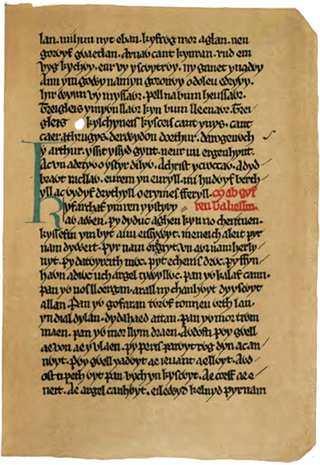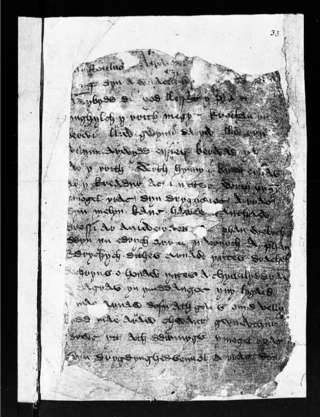
Until 1974, Merionethshire or Merioneth was an administrative county in the north-west of Wales, later classed as one of the thirteen historic counties of Wales.

Dolgellau is a town and community in Gwynedd, north-west Wales, lying on the River Wnion, a tributary of the River Mawddach. It was the traditional county town of the historic county of Merionethshire until the county of Gwynedd was created in 1974. Dolgellau is the main base for climbers of Cadair Idris and Mynydd Moel which are visible from the town. Dolgellau is the second largest settlement in southern Gwynedd after Tywyn and includes the community of Penmaenpool.

The National Library of Wales, in Aberystwyth, is the national legal deposit library of Wales and is one of the Welsh Government sponsored bodies. It is the biggest library in Wales, holding over 6.5 million books and periodicals, and the largest collections of archives, portraits, maps, and photographic images in Wales. The Library is also home to the national collection of Welsh manuscripts, the National Screen and Sound Archive of Wales, and the most comprehensive collection of paintings and topographical prints in Wales. As the primary research library and archive in Wales and one of the largest research libraries in the United Kingdom, the National Library is a member of Research Libraries UK (RLUK) and the Consortium of European Research Libraries (CERL).
The Hengwrt Chaucer manuscript is an early-15th-century manuscript of the Canterbury Tales, held in the National Library of Wales, in Aberystwyth. It is an important source for Chaucer's text, and was possibly written by someone with access to an original authorial holograph, now lost.

The White Book of Rhydderch is one of the most notable and celebrated surviving manuscripts in Welsh. Mostly written in southwest Wales in the middle of the 14th century it is the earliest collection of Welsh prose texts, though it also contains some examples of early Welsh poetry. It is now part of the collection of the National Library of Wales, having been preserved in the library at Hengwrt, near Dolgellau, Gwynedd, of the 17th century antiquary Robert Vaughan, who inherited it from the calligrapher John Jones and passed it to his descendants. The collection later passed to the newly established National Library of Wales as the Peniarth or Hengwrt-Peniarth Manuscripts.

The Black Book of Carmarthen is thought to be the earliest surviving manuscript written solely in Welsh. The book dates from the mid-13th century; its name comes from its association with the Priory of St. John the Evangelist and Teulyddog at Carmarthen, and is referred to as black due to the colour of its binding. It is currently part of the collection of the National Library of Wales, where it is catalogued as NLW Peniarth MS 1.

The Book of Taliesin is one of the most famous of Middle Welsh manuscripts, dating from the first half of the 14th century though many of the fifty-six poems it preserves are taken to originate in the 10th century or before.

Cymer Abbey is a ruined Cistercian abbey near the village of Llanelltyd, just north of Dolgellau, Gwynedd, in north-west Wales, United Kingdom.

Llanelltyd is a small village and community in Gwynedd, to the northwest of Dolgellau. The community population taken at the 2011 Census was 514, 57.4% of which speak Welsh.
Ieuan ab Owain Glyndŵr was reputedly the illegitimate son of the last native Welsh Prince of Wales; Owain Glyndŵr. The possibility of his existence was uncovered through the work of Peter Bartrum which is currently being edited by the University of Wales Aberystwyth. Ieuan ab Owain and his descendants are detailed in Peniarth Manuscript 287 in the hand of Robert Vaughan of Hengwrt (c.1592-1667) and also in the manuscript known as Harley 1969 by Griffith Hughes (1634–1665) - the original manuscripts are kept at the National Library of Wales, Aberystwyth and the British Library respectively.
Robert Powell Vaughan was an eminent Welsh antiquary and collector of manuscripts. His collection, later known as the Hengwrt–Peniarth Library from the houses in which it was successively preserved, formed the nucleus of the National Library of Wales, and is still in its care.

William Watkin Edward Wynne was a Welsh Conservative Party politician and antiquarian.

Llanfachreth is a settlement approximately three miles north-east of Dolgellau, Gwynedd, in the community of Brithdir and Llanfachreth within the historic boundaries of Merionethshire, Wales.

Tal-y-llyn, or Talyllyn, is a small hamlet and former parish in the community of Llanfihangel-y-Pennant in Gwynedd, Wales, situated at the end of Tal-y-llyn Lake close to the village of Abergynolwyn. The parish covered an area of 36,000 acres (15,000 ha). The River Dysynni flows out of the lake at this point, flowing down to enter Cardigan Bay north of Tywyn. Another lake known as Llyn y Tri Greyenyn or Llyn Bach was formerly located close to the border with the parish of Dolgellau.

Llanegryn is a village and a community in Gwynedd, north-west Wales. It was formerly part of the historic county of Merionethshire. It is located within Snowdonia National Park south of the Snowdonia (Eryri) mountain range. Travelling by road, it is around 4 miles (6 km) north-east of Tywyn and 17 miles (27 km) south-west of Dolgellau. The nearest railway stations are at Tonfanau and Llwyngwril, both less than 3 miles (5 km) away.
The Black Book of Chirk is a 13th-century Welsh-language manuscript, known also as the Chirk Codex. It is Peniarth 29 of the National Library of Wales, and deals with legal and historical matters. It contains also an elegy addressed at Llywelyn ap Iorwerth; king of Wales. This poem was probably written by his grandson Llywelyn ap Gruffudd who lived in the 13th century.

William Robert Maurice Wynne of Peniarth, Merionethshire, often referred to as W.R.M. Wynne, was a Conservative politician and prominent landowner who also made a notable contribution to the cultural life of Wales by donating the Peniarth Manuscripts to the National Library of Wales, Aberystwyth. Wynne also served as Conservative MP for Merioneth from 1865 to 1868. He stood down in 1868 when facing likely defeat by the Liberal candidate David Williams, following the Second Reform Act.

The Peniarth Manuscripts, also known as the Hengwrt–Peniarth Manuscripts, are a collection of medieval Welsh manuscripts now held by the National Library of Wales in Aberystwyth. The collection was originally assembled by Robert Vaughan of Hengwrt, Merionethshire. During the 19th century it was held in Peniarth Mansion, Llanegryn.

Peniarth 51 is a Welsh medieval manuscript, in the hand of the poet Gwilym Tew, written in the period 1460–1480. Although it is known that Tew wrote other manuscripts, Peniarth 51 is the only entire manuscript that can be proven to have been his work. It is kept in the National Library of Wales, Aberystwyth, as part of the Peniarth Manuscripts collection.

Nannau is a Georgian mansion and estate near the village of Llanfachreth, Gwynedd, North Wales, UK. The mansion was initially inhabited by the Welsh Nanney (Nannau) family, who were direct descendants of the Kings of Powys. For over 900 years, the Nannau estate was in possession of the same family.

















